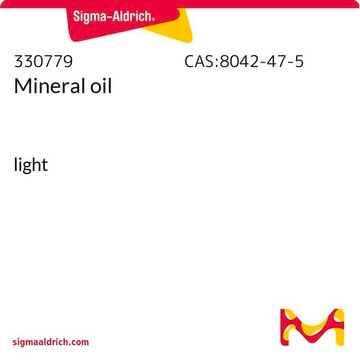132047
1,2,4-Trichlorbenzol
ReagentPlus®, ≥99%
About This Item
Empfohlene Produkte
Dampfdichte
>6 (vs air)
Qualitätsniveau
Dampfdruck
1 mmHg ( 40 °C)
Produktlinie
ReagentPlus®
Assay
≥99%
Form
solid or liquid
Selbstzündungstemp.
1060 °F
Expl.-Gr.
6.6 %, 150 °F
Brechungsindex
n20/D 1.571 (lit.)
bp
214 °C (lit.)
mp (Schmelzpunkt)
16 °C (lit.)
Löslichkeit
water: insoluble
Dichte
1.454 g/mL at 25 °C (lit.)
SMILES String
Clc1ccc(Cl)c(Cl)c1
InChI
1S/C6H3Cl3/c7-4-1-2-5(8)6(9)3-4/h1-3H
InChIKey
PBKONEOXTCPAFI-UHFFFAOYSA-N
Suchen Sie nach ähnlichen Produkten? Aufrufen Leitfaden zum Produktvergleich
Verwandte Kategorien
Allgemeine Beschreibung
Anwendung
1,2,4-Trichlorobenzene may be used as a solvent in the synthesis of indene-C60 bis adduct, which can find applications in high performance solar cells. It can also be used as a carrier gas in the textile industry.
Rechtliche Hinweise
Signalwort
Warning
H-Sätze
Gefahreneinstufungen
Acute Tox. 4 Oral - Aquatic Acute 1 - Aquatic Chronic 1 - Skin Irrit. 2
Lagerklassenschlüssel
6.1C - Combustible acute toxic Cat.3 / toxic compounds or compounds which causing chronic effects
WGK
WGK 3
Flammpunkt (°F)
235.4 °F - closed cup
Flammpunkt (°C)
113.0 °C - closed cup
Analysenzertifikate (COA)
Suchen Sie nach Analysenzertifikate (COA), indem Sie die Lot-/Chargennummer des Produkts eingeben. Lot- und Chargennummern sind auf dem Produktetikett hinter den Wörtern ‘Lot’ oder ‘Batch’ (Lot oder Charge) zu finden.
Besitzen Sie dieses Produkt bereits?
In der Dokumentenbibliothek finden Sie die Dokumentation zu den Produkten, die Sie kürzlich erworben haben.
Kunden haben sich ebenfalls angesehen
Unser Team von Wissenschaftlern verfügt über Erfahrung in allen Forschungsbereichen einschließlich Life Science, Materialwissenschaften, chemischer Synthese, Chromatographie, Analytik und vielen mehr..
Setzen Sie sich mit dem technischen Dienst in Verbindung.









